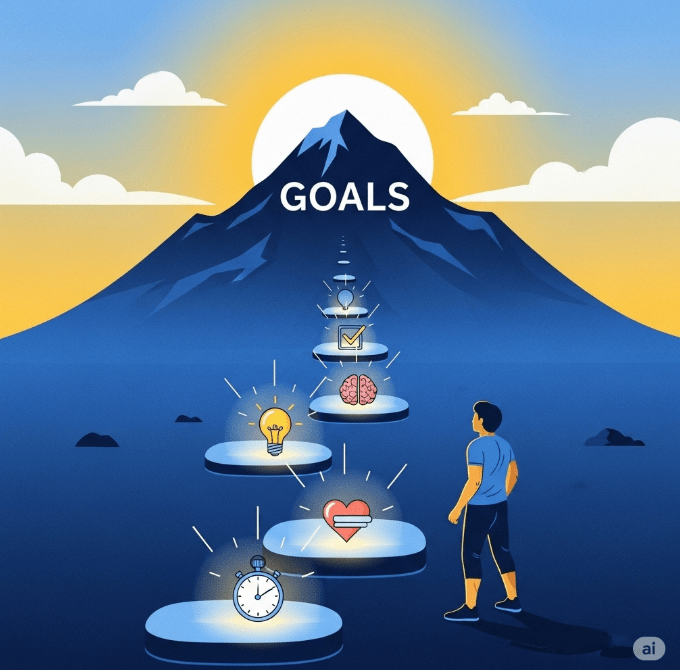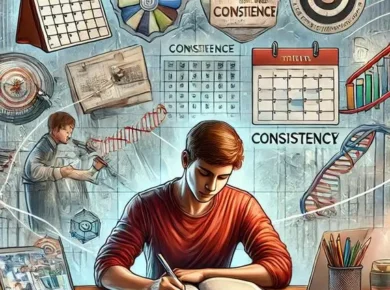Introduction: The Harsh Truth About Goals
Have you ever made a goal and failed to follow through? You’re not alone.
Studies show that over 80% of people abandon their New Year goals by February.
Why? It’s not because people are lazy. It’s because most people don’t understand how motivation works.
In this blog, we’ll break down the 5 science-backed strategies that help you stay motivated and crush your goals—no matter what.
The Science of Motivation: A Quick Primer
Motivation isn’t just about willpower. It’s a chemical process in your brain.
The key player? Dopamine—the “feel-good” neurotransmitter. It gets released when we anticipate rewards.
But here’s the catch: most people wait for motivation to strike. That rarely works.
The best strategy is to build a system that keeps motivation alive—even when life gets hard.
1. Set Tiny Goals (The Psychology of Small Wins)
The Power of Micro-Goals
Big goals are exciting. But they’re also overwhelming. That’s why most people quit.
Science says it’s better to start small.
According to research from Harvard, small wins trigger a dopamine release. Each win keeps you moving forward.
Example: If your goal is to write a book, your first goal should be “write 100 words today.”
Success Feeds Motivation
Success—even small success—makes you feel good. That feel-good rush fuels more action.
Over time, small steps snowball into big results.
✅ Quick Tip
Break your goal into micro-tasks that can be done in under 10 minutes. Track them using a checklist or app.
2. Create Identity-Based Habits
Instead of setting goals, become the person who achieves them. This is called identity-based change.
♂️ Example:
Don’t say “I want to run a marathon.” Say “I’m the kind of person who runs every day.”
Why it works: When your identity aligns with your goal, your brain works to keep things consistent.
Backed by Neuroscience
James Clear, in Atomic Habits, writes: “True behavior change is identity change.”
Start with the identity, and the actions will follow.
✅ Quick Tip
Write down your desired identity. Then list 3 small habits that align with it.
Example:
Identity: I’m a healthy person.
Habits: Drink water, walk 5,000 steps, eat veggies daily.
3. Use Dopamine on Purpose (Make Goals Fun)
Most people treat goals like homework. No wonder they quit.
Instead, trick your brain into loving the process.
Gamify the Journey
Turn your goal into a game. Add points, rewards, or streaks. Apps like Habitica or Forest do this brilliantly.
Each time you complete a task, your brain gets a dopamine hit.
The Reward Loop
Stanford researcher B.J. Fogg discovered something powerful: “Celebrate immediately after small wins to reinforce habits.”
Even a fist-pump or a “YES!” helps.
✅ Quick Tip
Pair a task you dislike with something fun.
Example: Listen to music while cleaning or exercising.
4. Make Failure Harder Than Success (Hack Your Environment)
Motivation doesn’t live in your brain alone—it lives in your environment.
Remove Friction
- Want to read more? Keep books near your bed.
- Want to stop eating junk? Don’t keep it at home.
- Want to wake up early? Put your alarm across the room.
Social Accountability Works
A study by ASTD showed:
People are 65% more likely to meet a goal if they commit to someone.
With a specific accountability partner, the success rate rises to 95%!
✅ Quick Tip
Tell a friend your goal. Better yet, post it publicly. Now failure has social cost—and that drives action.
5. Focus on the Process, Not the Outcome
Goals are good. But systems are better.
Process = Repeatable Success
- Outcome: Lose 5 kg
Process: Eat healthy and walk daily - Outcome: Start a blog
Process: Write 200 words a day
Outcomes are out of your control. Processes are not.
♀️ Why It’s Scientifically Smarter
Daniel Kahneman, Nobel-winning psychologist, showed we’re bad at predicting future rewards.
Focusing on the process keeps us grounded and consistent.
✅ Quick Tip
Every week, review your system. Ask:
– Did I follow my routine?
– If not, what broke?
– How can I make it easier?
Real-Life Story: How Riya Finally Launched Her Online Course
Riya, a marketing manager, wanted to launch her course. For 2 years, she failed.
She blamed time, stress, and burnout. Then she changed her approach:
- Wrote 100 words daily
- Called herself a “creator”
- Paired work with morning tea
- Shared her deadline publicly
- Focused on the process
3 months later, her course launched. She now teaches 500+ students.
Summary Table: 5 Science-Backed Motivation Hacks
| # | Strategy | Science Behind It | Tip |
|---|---|---|---|
| 1 | Tiny Goals | Dopamine from small wins | Create a 10-min checklist |
| 2 | Identity Habits | Cognitive Dissonance | Say “I am” not “I want” |
| 3 | Gamify | Reward loops | Use apps like Habitica |
| 4 | Environment | Choice architecture | Remove friction |
| 5 | Process Focus | Predictive bias | Review systems weekly |
Why This Works (And What to Do Next)
These aren’t fluffy tips. They are rooted in:
- Psychology
- Neuroscience
- Behavioral economics
Now it’s your turn. Don’t just read this. Pick one strategy and apply it today.
Start small. Build momentum. Motivation comes from action.
✅ Key Takeaways
- Motivation is a system, not a spark.
- Start small to keep dopamine flowing.
- Change your identity to change your habits.
- Use rewards and friction wisely.
- Focus more on systems than outcomes.
Further Reading and Resources
- Atomic Habits by James Clear
- Tiny Habits by B.J. Fogg
- Thinking, Fast and Slow by Daniel Kahneman
- Verywell Mind: What Is Motivation?
- APA: The Science of Willpower








